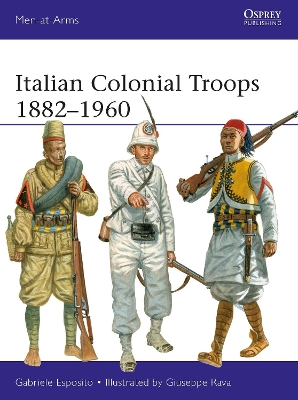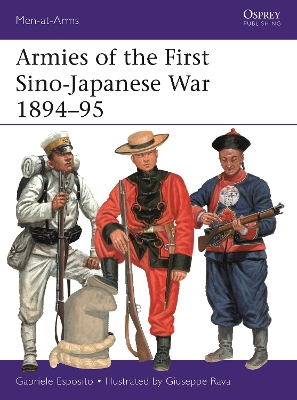Men-At-Arms (Osprey)
2 total works
A complete illustrated study of the varied range of Italian colonial units who served in East and North Africa.
Italy only unified as a nation in 1870 and was late, and therefore impatient, in the 'scramble' for Africa. An initial foothold in Eritrea/Somalia, north-east Africa, led to a disastrous defeat in Ethiopia in 1896 at the Battle of Adwa, but Italian Somaliland was later consolidated on the west coast of the Red Sea. During 1911, Italy also invaded Libya, securing the coast, however fighting continued throughout World War I and only ended in the early 1930s. A number of native colonial regiments were raised in both Italian East Africa and Libya (in the latter, even a pioneering paratroop unit), of which most fought sturdily for Italy against the Allies in 1940-43. These units had particularly colourful uniforms and insignia. Another small guard unit also served in the Italian concession at Tientsin, China in 1902-1943. After World War II, a remnant unit served on in Somalia under a UN mandate until 1960.
This intriguing volume describes and illustrates the dress and equipment used by these forces and details how they were deployed to maintain a colonial empire for over half a century.
Italy only unified as a nation in 1870 and was late, and therefore impatient, in the 'scramble' for Africa. An initial foothold in Eritrea/Somalia, north-east Africa, led to a disastrous defeat in Ethiopia in 1896 at the Battle of Adwa, but Italian Somaliland was later consolidated on the west coast of the Red Sea. During 1911, Italy also invaded Libya, securing the coast, however fighting continued throughout World War I and only ended in the early 1930s. A number of native colonial regiments were raised in both Italian East Africa and Libya (in the latter, even a pioneering paratroop unit), of which most fought sturdily for Italy against the Allies in 1940-43. These units had particularly colourful uniforms and insignia. Another small guard unit also served in the Italian concession at Tientsin, China in 1902-1943. After World War II, a remnant unit served on in Somalia under a UN mandate until 1960.
This intriguing volume describes and illustrates the dress and equipment used by these forces and details how they were deployed to maintain a colonial empire for over half a century.
Describes how newly modernized Japan waged war against China in its first overseas campaign, marking its rapid transition into Asia's leading military power only 30 years after emerging from centuries of feudalism.
After the Meiji restoration of the Japanese imperial regime in 1868–77, modernization along Western lines of Japan's industry, communications and land and naval forces advanced with remarkable speed and, by the 1890s, the rejuvenated nation was ready to flex its muscles overseas. The obvious opponent was the huge but medieval Chinese Empire, and the obvious arena for war was Korea, a nearby Chinese protectorate that Japan had long coveted. (A secondary campaign would be fought on Formosa/Taiwan, an autonomous Chinese island protectorate.)
In this study, author Gabriele Esposito describes the bloodthirsty course of the Japanese campaign in China, using colour illustrations and photos to showcase the organization, equipment and appearance of the various Chinese forces (China had no true national army), the Imperial Japanese Army and Navy, and, for the first time in English, the Korean and Formosan participants.
Japan's victory left it confident enough to challenge Imperial Russia and, nine years later, it defeated it at the Battle of Tsushima where two-thirds of the Russian fleet was destroyed by the Japanese Navy. This victory confirmed Japan's place as Asia's leading military power, soon to become a realistic rival to the West.
After the Meiji restoration of the Japanese imperial regime in 1868–77, modernization along Western lines of Japan's industry, communications and land and naval forces advanced with remarkable speed and, by the 1890s, the rejuvenated nation was ready to flex its muscles overseas. The obvious opponent was the huge but medieval Chinese Empire, and the obvious arena for war was Korea, a nearby Chinese protectorate that Japan had long coveted. (A secondary campaign would be fought on Formosa/Taiwan, an autonomous Chinese island protectorate.)
In this study, author Gabriele Esposito describes the bloodthirsty course of the Japanese campaign in China, using colour illustrations and photos to showcase the organization, equipment and appearance of the various Chinese forces (China had no true national army), the Imperial Japanese Army and Navy, and, for the first time in English, the Korean and Formosan participants.
Japan's victory left it confident enough to challenge Imperial Russia and, nine years later, it defeated it at the Battle of Tsushima where two-thirds of the Russian fleet was destroyed by the Japanese Navy. This victory confirmed Japan's place as Asia's leading military power, soon to become a realistic rival to the West.

